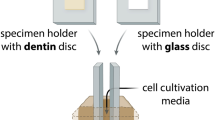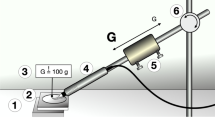Abstract
Objective
The aim of this study is to assess the effects of ultrasonic tip distance and orientation on the removal of a multispecies biofilm under standardized conditions in vitro.
Methods
Six-species biofilms were grown on hydroxyapatite discs for 64 h and treated with a magnetostrictive ultrasonic tip (Cavitron) placed either on contact or at 0.25- and 0.5-mm distance. The treatment was performed for 15 s with either the tip at right angle or sideways. Biofilm removal was evaluated by assessing the viable bacteria in each supernatant and compared to respective controls. In the latter, biofilms were mechanically removed and evaluated in supernatants to assess adhering and floating bacteria. Colony-forming units (CFU) were determined by cultivation on solid media. Any remaining biofilm on the treated discs was also visualized after staining with green-fluorescent SYTO® 9 stain using a confocal laser scanning microscope (CLSM). Mann–Whitney U tests and Bonferroni correction were used to analyze the results between the groups.
Results
Sideways application of the ultrasonic tip at distances of 0.25 and 0.5 mm removed as many bacteria as present on the control discs compared to the tip on contact (p < 0.05). All other application modes, especially the ultrasonic tip applied perpendicularly on contact, showed no statistical significance in removing biofilm.
Conclusion
Overall, data indicated that bacterial detachment depended on tip orientation and distance, especially when the tip was applied sideways similar to the clinical setting.
Clinical relevance
Biofilm removal by means of ultrasonic debridement remains a crucial aspect in the treatment of periodontal disease. To ensure sufficient biofilm removal, the tip does not necessarily require contact to the surface, but an application parallel to the surface on the side is recommended.




Similar content being viewed by others
References
Slots J (1979) Subgingival microflora and periodontal disease. J Clin Periodontol 6:351–382
Slots J (1999) Update on Actinobacillus Actinomycetemcomitans and Porphyromonas gingivalis in human periodontal disease. J Int Acad Periodontol 1:121–126
Slots J, Ting M (1999) Actinobacillus actinomycetemcomitans and Porphyromonas gingivalis in human periodontal disease: occurrence and treatment. Periodontol 20:82–121, 1999
Tunkel J, Heinecke A, Flemmig TF (2002) A systematic review of efficacy of machine-driven and manual subgingival debridement in the treatment of chronic periodontitis. J Clin Periodontol 29(Suppl 3):72–81, discussion 90–71
Meyer K, Lie T (1977) Root surface roughness in response to periodontal instrumentation studied by combined use of microroughness measurements and scanning electron microscopy. J Clin Periodontol 4:77–91
Breininger DR, O'Leary TJ, Blumenshine RV (1987) Comparative effectiveness of ultrasonic and hand scaling for the removal of subgingival plaque and calculus. J Periodontol 58:9–18. doi:10.1902/jop.1987.58.1.9
Torfason T, Kiger R, Selvig KA, Egelberg J (1979) Clinical improvement of gingival conditions following ultrasonic versus hand instrumentation of periodontal pockets. J Clin Periodontol 6:165–176
Badersten A, Nilveus R, Egelberg J (1984) Effect of nonsurgical periodontal therapy. II. Severely advanced periodontitis. J Clin Periodontol 11:63–76
Walsh TF, Waite IM (1978) A comparison of postsurgical healing following debridement by ultrasonic or hand instruments. J Periodontol 49:201–205. doi:10.1902/jop.1978.49.4.201
Caffesse RG, Sweeney PL, Smith BA (1986) Scaling and root planing with and without periodontal flap surgery. J Clin Periodontol 13:205–210
Brayer WK, Mellonig JT, Dunlap RM, Marinak KW, Carson RE (1989) Scaling and root planing effectiveness: the effect of root surface access and operator experience. J Periodontol 60:67–72. doi:10.1902/jop.1989.60.1.67
Fleischer HC, Mellonig JT, Brayer WK, Gray JL, Barnett JD (1989) Scaling and root planing efficacy in multirooted teeth. J Periodontol 60:402–409. doi:10.1902/jop.1989.60.7.402
Wylam JM, Mealey BL, Mills MP, Waldrop TC, Moskowicz DC (1993) The clinical effectiveness of open versus closed scaling and root planing on multi-rooted teeth. J Periodontol 64:1023–1028. doi:10.1902/jop.1993.64.11.1023
Lampe Bless K, Sener B, Dual J, Attin T, Schmidlin PR (2011) Cleaning ability and induced dentin loss of a magnetostrictive ultrasonic instrument at different power settings. Clin Oral Investig 15:241–248. doi:10.1007/s00784-009-0379-9
Lea SC, Felver B, Landini G, Walmsley AD (2009) Three-dimensional analyses of ultrasonic scaler oscillations. J Clin Periodontol 36:44–50. doi:10.1111/j.1600-051X.2008.01339.x
Lea SC, Landini G, Walmsley AD (2004) Thermal imaging of ultrasonic scaler tips during tooth instrumentation. J Clin Periodontol 31:370–375. doi:10.1111/j.1600-051X.2004.00491.x
Walmsley AD, Laird WR, Williams AR (1988) Dental plaque removal by cavitational activity during ultrasonic scaling. J Clin Periodontol 15:539–543
Khambay BS, Walmsley AD (1999) Acoustic microstreaming: detection and measurement around ultrasonic scalers. J Periodontol 70:626–631. doi:10.1902/jop.1999.70.6.626
Walmsley AD, Walsh TF, Laird WR, Williams AR (1990) Effects of cavitational activity on the root surface of teeth during ultrasonic scaling. J Clin Periodontol 17:306–312
Walmsley AD, Laird WR, Williams AR (1986) Displacement amplitude as a measure of the acoustic output of ultrasonic scalers. Dent Mater 2:97–100
Walmsley AD, Laird WR, Williams AR (1986) Inherent variability of the performance of the ultrasonic descaler. J Dent 14:121–125
Zhong P, Chuong CJ (1993) Propagation of shock waves in elastic solids caused by cavitation microjet impact. I: theoretical formulation. J Acoust Soc Am 94:19–28
Zhong P, Chuong CJ, Preminger GM (1993) Propagation of shock waves in elastic solids caused by cavitation microjet impact. II: application in extracorporeal shock wave lithotripsy. J Acoust Soc Am 94:29–36
Miller MW, Miller DL, Brayman AA (1996) A review of in vitro bioeffects of inertial ultrasonic cavitation from a mechanistic perspective. Ultrasound Med Biol 22:1131–1154
Thurnheer T, Rohrer E, Belibasakis GN, Attin T, Schmidlin PR (2014) Static biofilm removal around ultrasonic tips in vitro. Clin Oral Investig 18:1779–1784. doi:10.1007/s00784-013-1157-2
Shapiro S, Giertsen E, Guggenheim B (2002) An in vitro oral biofilm model for comparing the efficacy of antimicrobial mouthrinses. Caries Res 36:93–100, 57866
Gmur R, Guggenheim B (1983) Antigenic heterogeneity of Bacteroides intermedius as recognized by monoclonal antibodies. Infect Immun 42:459–470
Thurnheer T, Gmur R, Shapiro S, Guggenheim B (2003) Mass transport of macromolecules within an in vitro model of supragingival plaque. Appl Environ Microbiol 69:1702–1709
Doinikov AA, Bouakaz A (2010) Acoustic microstreaming around a gas bubble. J Acoust Soc Am 127:703–709. doi:10.1121/1.3279793
Walmsley AD, Williams AR (1991) Measurement of cavitational activity within ultrasonic baths. J Dent 19:62–66
Lea SC, Price GJ, Walmsley AD (2005) A study to determine whether cavitation occurs around dental ultrasonic scaling instruments. Ultrason Sonochem 12:233–236. doi:10.1016/j.ultsonch.2003.10.006
Riesz P, Kondo T (1992) Free radical formation induced by ultrasound and its biological implications. Free Radic Biol Med 13:247–270
Flemmig TF, Petersilka GJ, Mehl A, Hickel R, Klaiber B (1998) Working parameters of a magnetostrictive ultrasonic scaler influencing root substance removal in vitro. J Periodontol 69:547–553. doi:10.1902/jop.1998.69.5.547
Flemmig TF, Petersilka GJ, Mehl A, Hickel R, Klaiber B (1998) The effect of working parameters on root substance removal using a piezoelectric ultrasonic scaler in vitro. J Clin Periodontol 25:158–163
Walmsley AD, Lea SC, Felver B, King DC, Price GJ (2013) Mapping cavitation activity around dental ultrasonic tips. Clin Oral Investig 17:1227–1234. doi:10.1007/s00784-012-0802-5
Felver B, King DC, Lea SC, Price GJ, Damien Walmsley A (2009) Cavitation occurrence around ultrasonic dental scalers. Ultrason Sonochem 16:692–697. doi:10.1016/j.ultsonch.2008.11.002
Busscher HJ, Jager D, Finger G, Schaefer N, van der Mei HC (2010) Energy transfer, volumetric expansion, and removal of oral biofilms by non-contact brushing. Eur J Oral Sci 118:177–182. doi:10.1111/j.1600-0722.2010.00723.x
Schmidt JC, Zaugg C, Weiger R, Walter C (2013) Brushing without brushing?--a review of the efficacy of powered toothbrushes in noncontact biofilm removal. Clin Oral Investig 17:687–709. doi:10.1007/s00784-012-0836-8
Jepsen S, Ayna M, Hedderich J, Eberhard J (2004) Significant influence of scaler tip design on root substance loss resulting from ultrasonic scaling: a laserprofilometric in vitro study. J Clin Periodontol 31:1003–1006. doi:10.1111/j.1600-051X.2004.00601.x
Lea SC, Walmsley AD (2009) Mechano-physical and biophysical properties of power-driven scalers: driving the future of powered instrument design and evaluation. Periodontol 51:63–78. doi:10.1111/j.1600-0757.2009.00300.x, 2000
Guggenheim B, Guggenheim M, Gmur R, Giertsen E, Thurnheer T (2004) Application of the Zurich biofilm model to problems of cariology. Caries Res 38:212–222. doi:10.1159/000077757
Guggenheim M, Thurnheer T, Gmur R, Giovanoli P, Guggenheim B (2011) Validation of the Zurich burn-biofilm model. Burns 37:1125–1133. doi:10.1016/j.burns.2011.05.017
Guggenheim B, Giertsen E, Schupbach P, Shapiro S (2001) Validation of an in vitro biofilm model of supragingival plaque. J Dent Res 80:363–370
Muller P, Guggenheim B, Schmidlin PR (2007) Efficacy of gasiform ozone and photodynamic therapy on a multispecies oral biofilm in vitro. Eur J Oral Sci 115:77–80. doi:10.1111/j.1600-0722.2007.00418.x
Guggenheim B, Gmur R, Galicia JC, Stathopoulou PG, Benakanakere MR, Meier A, Thurnheer T, Kinane DF (2009) In vitro modeling of host-parasite interactions: the ‘subgingival’ biofilm challenge of primary human epithelial cells. BMC Microbiol 9:280. doi:10.1186/1471-2180-9-280
Author information
Authors and Affiliations
Corresponding author
Ethics declarations
Conflict of interest
All authors declare that they have no conflict of interest.
Funding
The work was supported by the Clinic of Preventive Dentistry, Periodontology and Cariology, Center of Dental Medicine, University of Zurich, Switzerland.
Ethical approval
This article does not contain any studies with human participants or animals.
Informed consent
For this type of study, formal consent is not required.
Conflict of interest
All authors do not report any conflicts of interests.
Funding
The present study was supported by the involved research facilities without external funding.
Rights and permissions
About this article
Cite this article
Gartenmann, S.J., Thurnheer, T., Attin, T. et al. Influence of ultrasonic tip distance and orientation on biofilm removal. Clin Oral Invest 21, 1029–1036 (2017). https://doi.org/10.1007/s00784-016-1854-8
Received:
Accepted:
Published:
Issue Date:
DOI: https://doi.org/10.1007/s00784-016-1854-8




